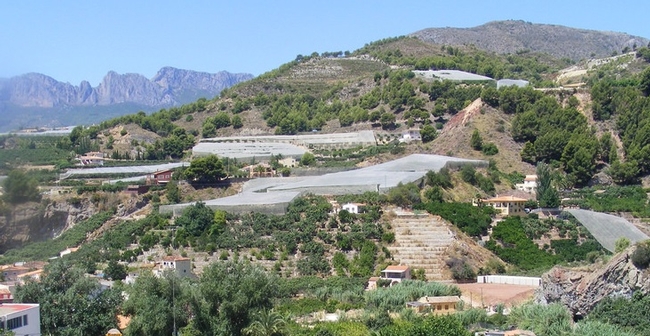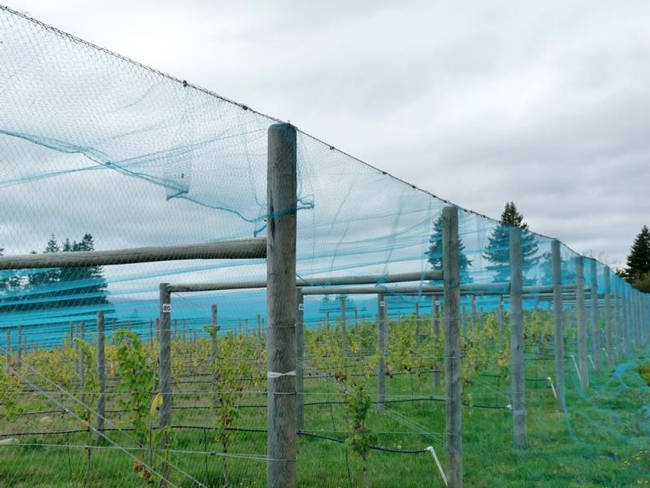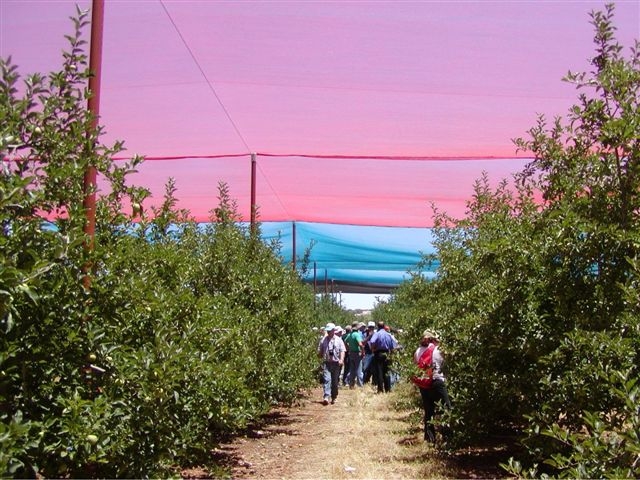
Posts Tagged: light
Netting in Your Orchard's Future?
At a recent meeting for current and prospective avocado growers near Visalia, Yosepha Shahak a retired researcher from Israel's Volcani Institute presented information on photo-selective netting. This netting was an outgrowth of netting that is used in the Mediterranean region to protect crops from frost damage and the unpredictable hail storms that can occur just as fruit might be coming to harvest. Netting is currently used in commercial orchards and vineyards throughout Europe. San Joaquin Valley growers like the idea of frost protection.
Netting over loquats (nespero) in Spain (Espana)
Netting over apples in Australia
Netting for light modification in Israel. Tractors can work here.
Photo-selective netting refers to covering crops by nets having the capacity to selectively filter the intercepted solar radiation, in addition to their protective function. The technology is based on plastic net products into which light dispersive and reflective elements are introduced during manufacturing. These nets are designed to screen various spectral bands of the solar radiation, and/or transform direct light into scattered light. The spectral manipulation intends to specifically promote desired physiological responses, which are light-regulated, while the scattering improves the penetration of the modified light into the inner plant canopy. So, depending on the crop, more and better fruit set, bigger fruit and some other desirable properties. The netting can also substantially reduce evaporative demand and wind damage. This can lead to not only lower water use, but also such water stress related diseases, such as blight caused by Botryosphaeria fungi. Lower evaporative demand and less water application can lead to less salt damage.
A recent additional aspect to the photo-selective nets refers to their effects on pest behavior. The photo-selective netting concept was developed and tested in Israel in ornamental, vegetable and fruit tree crops. It is gradually spreading all over the world, for implementation in different crops, climatic regions and cultivation methods. Applying it to avocado orchards is going to require pruning and keeping trees so that they can be picked and pollinated. And would probably lead to high density orchards.
And how we do pest management – more or less, and maybe not by helicopter?
This might also be the future for how citrus is grown in an HLB environment. 24 sprays a year to control ACP in Florida -Yikes.
A link to a Shahak talk that she gave to Washington state apple growers can be found at:
New Early Detection of Citrus HLB
Kearney Research and Extension Center, University of California Cooperative Extension
California is the major producer of fresh market citrus in the U.S., a $2 billion industry that is threatened by a devastating disease called citrus Huanglongbing (HLB). Unfortunately, there is no cure for this disease and if a tree gets infected, it will die in a few years. In Florida, HLB was first seen in 2005, but after a few years the entire state of Florida got infected. Today, about 60% of Florida citrus has gone, mostly because there was no efficient HLB monitoring practice. HLB diagnosis using laboratory-based methods required manual sampling and they were time and effort consuming. An efficient HLB management requires high spatial and temporal resolution monitoring and eradication of infected trees. Therefore, a diagnosis sensor is needed for detecting HLB infected canopies before the development of symptoms. For high resolution monitoring, the sensor should also be able to conduct rapid and inexpensive inspection with high accuracy.
Starch accumulation in HLB infected leaves is an early indication of the disease. Starch has an optical characteristic of rotating the polarization plane of light. We employed this characteristic of starch to develop an early detection methodology in which the sensing system was very sensitive to the rotation in polarization plane of light. The sensor has a customized illumination system including 10 high-power and narrow band LEDs at 591 nm and a polarizing film. The sensor also has a monochrome camera equipped with a linear polarizing filter that is set in a perpendicular direction to the polarizing film of the illumination system.
Starch accumulation in an HLB infected leaf generates blotchy mottle in an asymmetrical yellowing pattern. Deficiency of certain nutrients such as Mg and Zn causes symptoms similar to HLB.
The sensor was mounted on a gator vehicle and was tested in a citrus grove in Florida. The polarized images acquired from healthy, HLB, and Zn deficient canopies were further analyzed for diagnosis purpose.
HLB samples were accurately identified from healthy and Zn deficient samples. Also, the sensor was able to detect HLB within Zn deficient samples.
The polarized imaging methodology was adopted in two separate studies at the University of Florida to investigate the earliest time HLB can be diagnosed by polarized imaging technique after infection. In one study, two-year old Valencia orange plants were inoculated using disk-graft method.
Time-lapse polarized images of leaves from inoculated citrus plants were acquired on a weekly basis. HLB symptoms (as starch accumulation) started to become visible in the polarized images five weeks after inoculation, while the plants were still in asymptomatic stage.
In another study, the polarized imaging methodology was employed to detect HLB in insect inoculated citrus seedlings while in asymptomatic stage. Citrus seedlings were exposed to intensive HLB-positive Asian Citrus Psyllid (ACP) feeding. Polarized images were acquired two times; once after one month after inoculation and again two months after inoculation. As well as HLB detection, the level of infection was obtained for different leaf samples. Polymerase chain reaction (PCR) tests were conducted to validate the HLB status and the level of infection in each leaf sample.
Currently, we focus on improving the accuracy and early detection performance of the polarized imaging sensor and developing a commercialized product for practical in-field diagnosis. This affordable tool can help the California citrus growers to protect their groves from HLB.
Photos, from top to bottom:
Sensor Prototype
Leaf Symptoms of HLB and Zn Deficiency
Time Lapse Images of HLB Infected Leaves Over Time
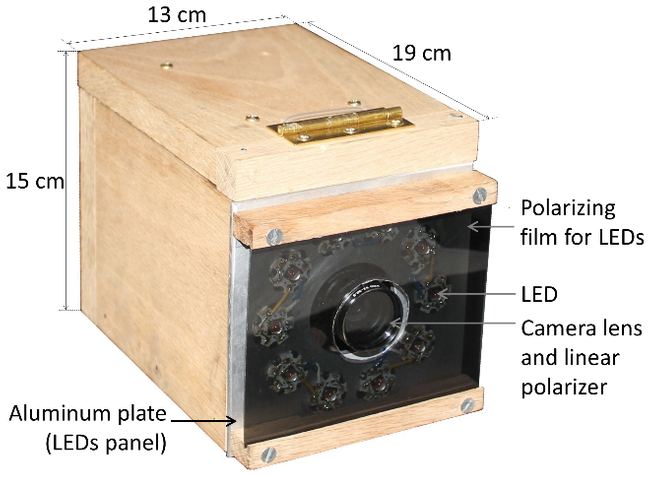
Detection Sensor Prototype HLB
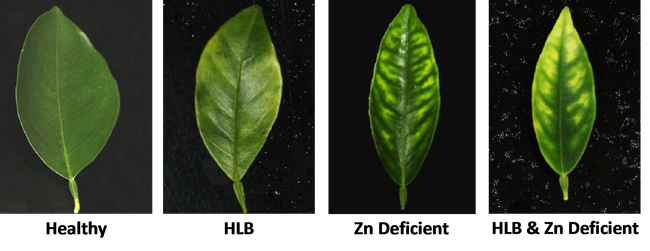
HLB healthy and Zn deficient
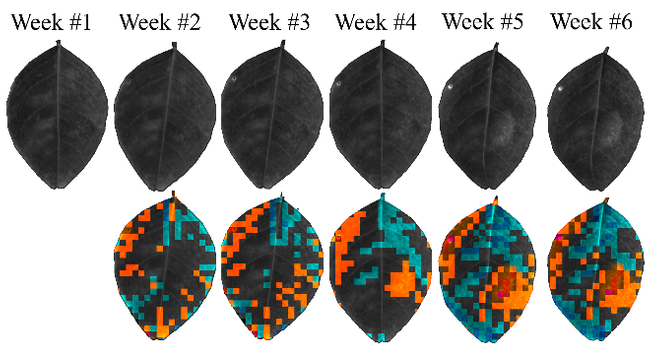
HLB leaves starch
Avocado Dieback – Blight vs. Phytophthora vs. Lack of Light
When you see dieback in an avocado it could be due to several reasons, and here are three very common causes of dieback, one of which has been especially common when there is little rain. The first major cause of dieback is an overgrown tree where there is no light that penetrates into the canopy. Branches with leaves in a darkened interior will naturally shut down and dieback, leaving these twiggy dried out branches. This is a natural process whereby the tree just gets rid of leaves that are not performing.
Another cause of dieback is our old friend Avocado Root Rot, Phytophthora cinnamomi. This causes dieback, also called “stag horning” because of the dead branches standing out from the surrounding canopy. This is normally accompanied by a thinning canopy with smaller, yellow leaves and a lack of leaf litter because of lack of energy. It's also hard to find roots and if they are found, they are black at the tips and brittle.
http://www.ipm.ucdavis.edu/PMG/r8101311.html
The third major cause of dieback is a result of water stress. This shows up with low water pressure, at the top of the hill where the most wind occurs, where a sprinkler gets clogged, when the irrigation schedule is not meeting tree's needs or when there is not adequate rainfall to get sufficient leaching. And after four years of drought, this is very common. This appears as dead spots in the canopy, a branch here and there where the leaves have died and are still hanging. It's been called “salt and pepper” syndrome, because it can have a few branches here and there that have died back while the rest of the canopy is normal, the leaves are normally sized and green. In young trees, in severe cases, the fungus that causes this blight can work its way down to the graft union and kill the tree. In mature trees, it just causes an unthrifty look to the tree. Although we have always seen this problem in avocado orchards, this has become a very common affliction in orchards these last few years
http://www.ipm.ucdavis.edu/PMG/r8101311.html
1) Lack of light dieback
2) Phytophthora cinnamomi dieback
3) Stem and Leaf Blight

lack of sun

root rot vs healthy

stem blight

